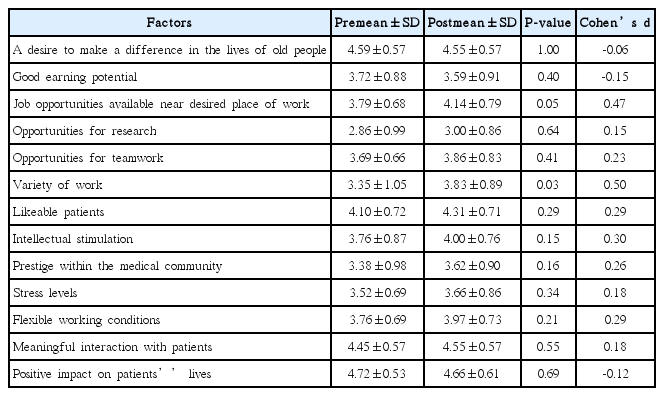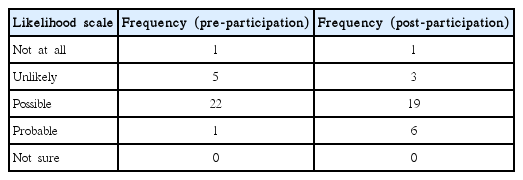Effects of an integrated geriatric group balance class within an entry-level Doctorate of Physical Therapy program on students’ perceptions of geriatrics and geriatric education in the United States
Article information
Abstract
This study was aimed at determining the effect of an integrated group balance class for community-dwelling older adults within entry-level physical therapist coursework on student perceptions of geriatric physical therapy and geriatric physical therapy education. Twenty-nine Doctor of Physical Therapy (DPT) students, 21–33 years old, in their second year of coursework in 2012, participated in an integrated clinical experience with exposure to geriatric patients at an outpatient facility at the Louis Stokes Cleveland Department of Veterans Affairs Medical Center in Akron, Ohio, USA. Student perceptions were collected before and after participation in the 8-week balance class. The Wilcoxon sign-ranked test was used to identify differences in perceptions after participation in the group balance class. Cohen’s d-values were calculated to measure the size of the pre-participation to post-participation effect for each measure. At the conclusion of the group class, the DPT students demonstrated an increase in positive perceptions of geriatric physical therapy in 8 measures, with small effect sizes (d=0.15–0.30). Two perceptions of geriatric physical therapy demonstrated a significant positive increase (P<0.05) with moderate effect sizes (d=0.47 and d=0.50). The students’ perceptions of geriatric education in the curriculum demonstrated a large positive effect for quality (d=1.68) and enjoyment (d=1.96). Positive changes were found in most of the perceptions of geriatrics and geriatric education after participation, suggesting that integrated clinical experiences with geriatric patients are an effective way to positively influence perceptions of physical therapist practice with older adults.
Some researchers have reported that physical therapy students generally have a lack of knowledge and negative perceptions toward working with older adults [1,2]. In a study carried out by Hobbs et al. [1], less than 2% of students requested a geriatric clinical elective during their entry-level physical therapist education. That study reported that even though clinical education helped to improve student attitudes and knowledge of older adults, students were still not adequately informed about the geriatric population by graduation [1].
When included as a component within didactic coursework, integrated clinical experiences become a teaching method that unifies students’ educational foundation with proficiency in clinical skills [3]. Integrated clinical experiences are beneficial in preparing students for future clinical internships and providing adequate exposure to various patient populations [3]. Given the reluctance of some physical therapy students to work with the geriatric population, it is crucial to identify educational methods that positively impact student perceptions of geriatrics. The purpose of this study was to determine the effect of an integrated outpatient group balance class for community-dwelling older adults within entry-level physical therapist didactic coursework on student perceptions of geriatric physical therapy and geriatric physical therapy education.
Study design
This study was completed as a survey before and after participation by a cohort of students.
Subjects
The participants included second-year Doctor of Physical Therapy (DPT) students in an entry-level program at Walsh University in North Canton, Ohio, United States in 2012.
Technical information
As a component of the course on the management of patients with neurological conditions, students participated in a weekly group balance class at a community-based outpatient clinic at the Louis Stokes Cleveland Department of Veterans Affairs Medical Center (LSCDVAMC). This class included 20 community-dwelling older adults with balance impairments and was scheduled at 2 different times (10 in each class) for 8 consecutive weeks. The students were assigned to 3 groups (comprised of 10, 10, and 9 students, respectively) and each week, 2 groups of students provided the treatment intervention for the geriatric participants enrolled in the balance class. The students rotated through the 2 geriatric participant groups each week, such that they were exposed to both groups of patient participants approximately 5 times within the 8-week course. Two licensed physical therapists directly supervised the students.
During the first week of the group class, the students completed a template assessment of each patient participant, which included a medical history (including falls), as well as the following outcome measures across the domains of the International Classification of Function: The Berg Balance Scale, the 8 Foot Up-and-Go Test, the 10-meter walk test, the Modified Clinical Test of Sensory Integration of Balance, and the Activities-Specific Balance Confidence Scale. Over the 7 weeks after the initial assessment, the instructors provided the students with specific exercise descriptions to complete in a group format.
Student perceptions of geriatrics were collected before and after participation in the group balance class using an instrument originally validated to measure perceptions of geriatric medicine by medical students [4]. This survey was adapted with permission to measure perceptions of geriatric physical therapy (Appendix 1).
Statistics
All statistical analyses were completed using SAS ver. 9.3 (SAS Institute Inc., Cary, NC, USA). The Wilcoxon sign-ranked test was used to determine if differences were present for each item after participation in the group balance class. Cohen’s d-values were calculated in order to determine differences in the students’ perceptions of geriatrics before and after participation in the exercise class. The results were quantified using the mean, standard deviation (SD), P-value, and Cohen’s d. The interpretation of the effect size was as follows: 0.0–0.19, trivial; 0.20–0.49, small; 0.50–0.79, moderate; and >0.80, large [5].
Ethical approval
The study was approved by the Human Subjects Review Board at Walsh University (HSR12-41) and the Institutional Review Board of LSCDVAMC.
A total of 29 DPT students, 21–33 years old, completed the surveys, including 3 males and 26 females. The results of the 13 questions measuring student perceptions of geriatric physical therapy are presented in Table 1. Based on a 5-point Likert scale (with 5 being the highest value), 4 of the pre-participation measures of perceptions of geriatric physical therapy had a mean score above 4.0, indicating highly positive perceptions at baseline. These included ‘a desire to make a difference in the lives of old people,’ ‘likeable patients,’ ‘meaningful interaction with patients,’ and ‘positive impact on patients’ lives.’ For each of these 4 perceptions except ‘likeable patients,’ a trivial decrease was observed in the post-participation mean (Cohen’s d between −0.15 and −0.06). For ‘likeable patients,’ a small positive effect was found (d=0.29) from pre-participation to post-participation.

Student perceptions of a career in geriatric physical therapy pre-participation and post-participation in a group balance class at Walsh University in North Canton, Ohio, United States in 2012
The remaining 9 student perceptions of geriatric physical therapy had a mean pre-participation value between 2.86 and 3.76 (SD between 0.68 and 1.05). Within these, all but 1 (‘good earning potential’) demonstrated a positive shift from before to after participation (d=−0.15). Trivial but positive effect sizes were obtained for ‘opportunities for research’ (d=0.15) and ‘stress levels’ (d=0.18). Small positive effects were found for ‘opportunities for teamwork’ (d=0.23), ‘intellectual stimulation’ (d=0.30), ‘prestige within the medical community’ (d=0.26), and ‘flexible working conditions’ (d=0.29). None of these findings were significant based on the associated P-values. Significant results were demonstrated from before to after participation for ‘job opportunities available near a desired place of work’ (P=0.049), with a small to moderate effect size (d=0.47), and ‘variety of work’ (P=0.03), with a moderate effect size (d=0.50).
The likelihood of student participants to choose a career in geriatric physical therapy is presented in Table 2. As a result of exposure to the group exercise class, 5 students stated that it was more probable that they would seek out a career in geriatric physical therapy. For the 3 questions used to measure student perceptions of the quality of geriatric education in the DPT curriculum, the mean pre-participation score was 1.86 (SD=1.52), indicating perceived quality at the poor end of the scale. The mean post-participation score was 4.1 (SD=0.76), indicating an improved perception of quality, towards the excellent end of the scale. Students’ enjoyment in working with the geriatric population demonstrated similar results, with pre-participation and post-participation means of 1.55 (SD=1.78) and 4.31 (SD=0.89), respectively. These changes resulted in large Cohen’s d effect size values of 1.68 and 1.96, respectively (P<0.01) (Table 3). The students reported that they would find additional education in geriatrics to be useful both before and after participation (d=−0.10).

Responses before and after participating in a group balance class to the question “How likely are you to choose a career in geriatric physical therapy?” at Walsh University in North Canton, Ohio, United States in 2012

Physical therapy student participants’ perceptions of geriatric education in the curriculum at Walsh University in North Canton, Ohio, United States in 2012
The results showed positive changes in most of the perceptions of geriatric physical therapy from pre-participation to post-participation, with trivial to moderate effect sizes. Perceptions of geriatric physical therapy education exhibited significant changes after participation, with large positive effect sizes for the quality and enjoyment of training. An interesting finding was that students already had positive attitudes toward older adults at the beginning of the study. In our sample, students held high perceptions at baseline (>4 points out of a possible 5) for the following categories: ‘a desire to make a difference in the lives of old people,’ ‘likeable patients,’ ‘meaningful interaction with patients,’ and a ‘positive impact on patients’ lives.’ Therefore, it was somewhat unlikely that these criteria would show a significant improvement after participation with geriatric patients. A positive finding here is that the perceptions did not decline significantly, but remained high.
Regarding the student perceptions of geriatric education, a significant difference was found between mean pre-participation and post-participation values for the item ‘how much did you enjoy your experiences in geriatrics at physical therapy school,’ with a large positive effect after participation. Interestingly, students indicated that they needed more instruction in geriatric physical therapy pre-participation and continued to indicate a strong need for additional education post-participation. This indicates that despite reporting high quality and enjoyment scores post-participation, students continued to see the need for additional instruction about geriatric physical therapy within the entry-level program. This finding is viewed quite positively by the investigators, as it may indicate that the students recognize that there is more information that they do not know but need to know to make them better geriatric physical therapists. Perhaps working with these older adults supported a drive for more knowledge.
The limitations of this study included a small sample size and a condensed time frame from commencement to completion of the study. Similarly, because the research was focused on second-year students currently in the program, it was not possible to implement controls or randomization of the subjects. Additional research on the effects of integrated clinical exposure on student perceptions of other specific populations (e.g., pediatrics; neurological patients) is warranted as well.
In conclusion, our findings demonstrate the positive effect of exposure to geriatric patients in a clinical setting through an integrated clinical experience with older adults. It is clear that experiences such as these have overall positive effects on perceptions of geriatric physical therapy and geriatric education. Additionally, we observed an overall increase in the number of students who indicated that they were likely to work with geriatric populations after participation in the group exercise class.
Notes
Conflict of interest
No potential conflict of interest relevant to this article was reported.
Supplementary materials
Audio recording of the abstract
Raw data are available from: https://doi.org/10.7910/DVN/XZSRA1
